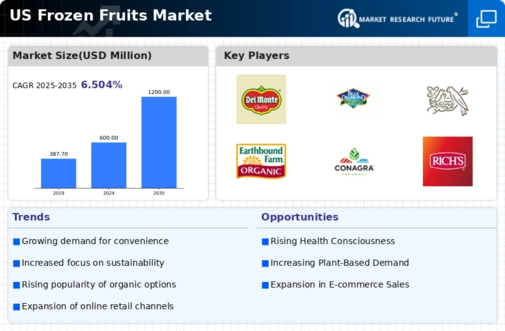The Recent Developments segment of the US Frozen Fruits Market has shown notable trends that reflect evolving consumer preferences and innovation in the industry. One of the emerging trends is the increased variety of minimally processed, single-serve options, catering to the growing demand for convenient and healthy snacks. This focus on higher quality and convenience appeals to busy consumers looking for nutritious options without compromising on taste or processing.
Furthermore, the addition of unique flavors such as banana and coconut to frozen fruit products has gained traction, attracting adventurous consumers and enhancing market diversity.This flavor innovation highlights the importance of variety in driving consumption and market appeal. Additionally, the expansion of the frozen food market that includes frozen snacks and meals underscores the integration of frozen fruits into wider culinary uses, promoting their use in versatile meal preparations. The growth in these areas creates opportunities for brands to explore new recipes and marketing strategies, positioning frozen fruits as a key ingredient across various meal categories.
Consequently, these developments play a vital role in shaping the US Frozen Fruits Market landscape, meeting demand while fostering growth and competition.
US Frozen Fruits Market Key Players and Competitive Insights
The US Frozen Fruits Market is characterized by its dynamic competitive landscape, driven by a diverse array of companies attempting to meet increasing consumer demand for convenience and healthy eating options. As consumers become more health-conscious, the demand for frozen fruits that preserve nutritional value and offer convenience continues to rise. This market is also shaped by changing consumer preferences, innovations in product offerings, and effective marketing strategies that emphasize the quality and versatility of frozen fruit products. Companies are increasingly focused on sustainability, sourcing practices, and product innovation to maintain a competitive edge in this growing sector.
The competitive atmosphere encourages industry players to invest in research and development to enhance product quality and expand their market reach.Del Monte Foods holds a prominent position in the US Frozen Fruits Market due to its extensive product portfolio and strong brand recognition. The company’s dedication to quality is evident in its wide range of frozen fruit offerings, catering to health-conscious consumers looking for nutritious options. Del Monte's established distribution network allows it to maintain a significant presence in supermarkets and grocery stores across the United States, ensuring that its frozen fruit products are readily accessible to consumers.
The company's strengths lie in its commitment to innovation, as it continuously develops new products to keep pace with consumer trends. Additionally, its robust marketing strategies and partnerships with retailers bolster its competitive position, laying the groundwork for sustained growth in the freezing fruits category.Blue Diamond Growers, while primarily recognized for its almonds, has also made significant strides in the US Frozen Fruits Market by leveraging its expertise in agriculture and food processing to diversify its offerings. The company’s core products often include frozen fruit products that complement its existing almond product range, providing consumers with additional choices.
Blue Diamond Growers has established a strong presence in the market by focusing on high-quality, sustainable sourcing and innovative processing methods that ensure the freshness and flavor of its frozen fruits. Strengths of the company include a well-managed supply chain and strategic marketing initiatives that highlight the versatility of its products. The company continues to explore mergers and acquisitions to expand its market reach, seeking partnerships and collaborations that enhance its portfolio and strengthen its position as a key player in the US Frozen Fruits Market.
Through these strategies, Blue Diamond Growers aims to maintain its reputation for quality while responding to evolving consumer demands.
Key Companies in the US Frozen Fruits Market Include
- Del Monte Foods
- Blue Diamond Growers
- Kraft Heinz Company
- Archer Daniels Midland
- Nestle
- Earthbound Farm
- Dole Food Company
- Conagra Brands
- Rich Products Corporation
- Berrytown
- Pinnacle Foods
- SunOpta
- General Mills
- Wanted Foods
- Ocean Spray Cranberries
US Frozen Fruits Market Industry Developments
In recent months, the US Frozen Fruits Market has seen significant developments driven by consumer demand for convenience and healthy options. Companies like Del Monte Foods and Dole Food Company have been expanding their product lines, introducing innovative blends that appeal to health-conscious consumers. Current affairs also indicate an increase in frozen fruit consumption attributed to a rise in smoothies and healthy snacks. Notably, the market is experiencing a valuation growth, positively impacting businesses such as Kraft Heinz Company and General Mills, which have reported robust sales figures reflecting this trend.
In terms of mergers and acquisitions, Archer Daniels Midland completed its acquisition of a frozen fruit processing facility in September 2023, enhancing its capacity in the sector. Meanwhile, Earthbound Farm announced its collaboration with Ocean Spray Cranberries to launch a new line of frozen fruit snacks in June 2023, further highlighting the strategic partnerships in the market. The last 2-3 years also witnessed pivotal changes, including the rising focus on sustainable sourcing practices among companies like Rich Products Corporation and Conagra Brands, driven by consumer preferences shifting towards environmentally friendly products.



















Leave a Comment